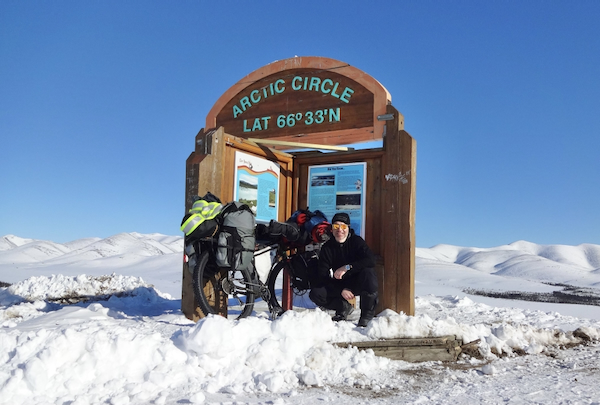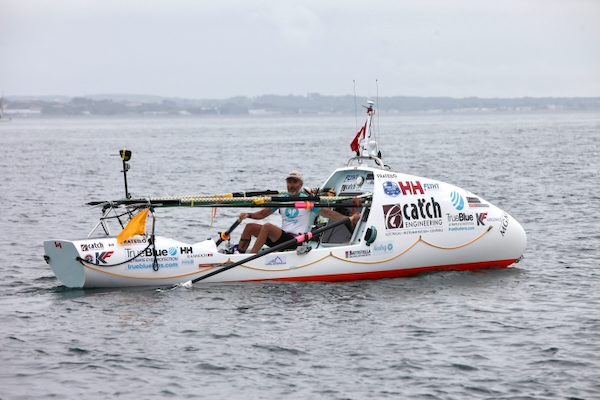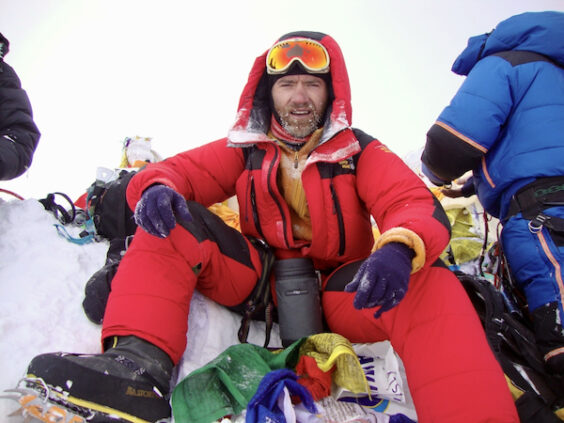By Kim Gray
As Toque & Canoe enters a new year, we find ourselves feeling a bit restless here in our cozy Alberta office.
If you’re also dreaming of travel (it is January in Canada, after all), who better to inspire us than Calgary-based adventurer Laval St. Germain?
A pilot with Canadian North Airlines, a company specializing in Arctic travel, St. Germain is perpetually on the move.
His journey began as a National Geographic enthusiast growing up in Morinville, Alberta, and his insatiable curiosity about the world—along with his desire to constantly challenge himself—continues to lead him to extraordinary places.
Thank you for our enlightening conversation, Laval. You are a storyteller like no other.
Few people inspire us to strap on our snowshoes and head for the mountains quite like you do!
Laval St. Germain / Canadian Rockies / Photo by www.davebrosha.com
Q: You wear many hats: husband, father, pilot, athlete, and traveler. What draws you to travel?
A: I love the concept of adventure—the adventure life. There’s something exhilarating about being fully engaged, even when I feel scared. When I’m outdoors pushing my limits—whatever that may be—I often find myself in moments of sheer awe.
For instance, I recently biked across Oman. At one point, I found myself cycling down a road alongside a herd of camels. The only sound was their leather-soled hooves softly thudding against the pavement.
It felt like I was living inside a National Geographic story. These are the experiences I crave.
Q: You’ve called your aviation career a gift. Why is that?
A: I owe a lot to my dad, Guy, for steering me toward this career and my mom, Charlotte, for supporting my early flying ambitions.
My pull towards nature has always been strong. Being a pilot has granted me access to pristine wilderness—landing on secluded lakes, flying swiftly through mountain valleys, and now as an airline captain, witnessing the northern lights from the cockpit at altitudes over 10,000 meters above the Arctic Circle.
Often, after landing, I turn to my first officer and say, “Can you believe we just got paid for this?”
Q: How else do you enjoy traveling?
A: I favor human-powered modes of travel. Trail running in the mountains, feeling the soft earth beneath my feet and savoring the alpine scent. Skiing up hills, with sweat stinging my eyes and my muscles burning, only to be rewarded with a spiritual descent through the powdery snow of Alberta. I cherish pedaling a loaded bicycle, relying on myself to navigate the journey.

Laval St. Germain / Arctic Circle / Photo courtesy of Laval St. Germain
Q: What essential items do you always carry?
A: I never leave home without a headlamp and a small multi-tool. The headlamp came in handy during a power outage at a sketchy hotel in Cameroon, and my multi-tool saved the day when I had to fix a broken ski binding in Nunavut. It even popped open a cold beer in Bolivia!
However, what I truly carry is humility and openness. I believe my most profound human connections occur when I let my vulnerability show, whether that’s with a shepherd in the Iraqi mountains or an elder from the Dené community in the Canadian Arctic. Traveling this way fosters genuine connections.
Q: In 2010, you became the first Canadian to summit Mount Everest without supplemental oxygen, and in 2015, you fat-biked across the Arctic. What other extraordinary experiences fill your resume?
A: In 2016, I rowed solo across the North Atlantic Ocean, from Halifax to France.
The memories are endless! One that stands out was a late-night chat over two-way radio with a Canadian from Newfoundland working on an offshore oil platform. The stormy seas surrounded me, and I was feeling lonely, nerves frayed from the relentless waves and a few capsizes.
In the dim red glow of my radio, we shared stories about work, summers back home, and our families, longing for them. The only thing missing from that Canadian moment was a Tim Horton’s coffee and CBC Radio playing softly in the background.

Laval St. Germain / North Atlantic Ocean solo rowing expedition / Photo by Janet St. Germain
Q: Can you share your experience of canoeing with your then 14-year-old son, Eric, starting from Great Bear Lake in the Northwest Territories and following the Great Bear and Mackenzie Rivers to Norman Wells?
A: This trip took place a year after the heartbreaking loss of our eldest son, Richard, who was 21.
On July 15, 2014, Richard had just arrived in Norman Wells to start his career as a bush pilot. Tragically, while canoeing with a friend, their canoe capsized, and our adventurous son lost his life.
This canoe journey with Eric was my way of confronting my grief head-on.
Adventure and the wilderness have given me so much, yet taken so much more. Climbing Everest without oxygen eventually came to an end. Rowing across the Atlantic led me to safety on land. But losing a child leaves a wound with no closure and no safe haven.
Losing a child reshapes how you view death and sorrow. You may find joy amidst the rapids and laughter in the cold splashes, yet still find yourself weeping at night or collapsing into your partner’s embrace in grief.
It’s often described as a form of agility—the ability to navigate through contrasting emotions.
Adventure teaches profound lessons. There are gut-wrenching lows and unimaginable highs. Ultimately, regardless of the challenges faced, you must keep moving forward.
Q: You’re associated with the Speakers Bureau of Canada and are known for helping turn “dreams into goals into reality.” Why do you feel so passionately about travel?
A: Humans are inherently designed to move. Prior to agriculture, most of our ancestors were nomadic. We’ve evolved to traverse great distances. More importantly, we may be the only species capable of imagining what’s beyond a valley, across a body of water, or over a mountain.
Our capacity to dream about destinations propels our journeys. I worry that with social media and Google Earth showcasing countless images of our planet, we might lose our sense of wanderlust.
Platforms like Instagram, Twitter, and Facebook can’t capture the sensations—the wind, the waves, the aromas, the temperature, or the warmth of personal connections.
I always encourage people to “unzip their tents and step outside.” It can be easy to stay indoors. Personally, I find it difficult to leave my family—my wife, Janet, our daughter Andrea, and our son Eric.
However, once you step outside, momentum takes over, and you’re off on your adventure.
The Norwegians have a wonderful expression, “dørstokkmila,” meaning the hardest step is simply putting on your shoes and heading out the door.

Laval St. Germain / Mount Everest, Nepal / Photo courtesy of Laval St. Germain
Q: You’ve summited the tallest peaks on all seven continents and plan to cycle across Cuba this spring. What drives your adventures?
A: Life is fleeting, and this realization pushes me to savor every moment while I can.
I cherish the quote by Hunter S. Thompson: “Life should not be a journey to the grave with the intention of arriving safely in a pretty and well-preserved body, but rather to skid in broadside in a cloud of smoke, thoroughly used up, totally worn out, and loudly proclaiming ‘Wow! What a ride!’”
Toque & Canoe is an award-winning digital platform showcasing stories about travel culture in Canada and beyond. Connect with us on Twitter, Instagram and Facebook



